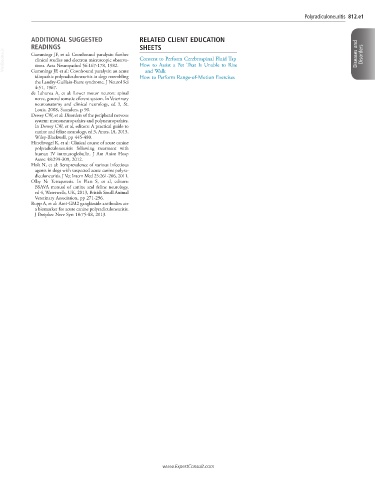Page 1612 - Cote clinical veterinary advisor dogs and cats 4th
P. 1612
Polyradiculoneuritis 812.e1
ADDITIONAL SUGGESTED RELATED CLIENT EDUCATION
READINGS SHEETS
VetBooks.ir Cummings JF, et al: Coonhound paralysis: further Consent to Perform Cerebrospinal Fluid Tap Diseases and Disorders
clinical studies and electron microscopic observa-
How to Assist a Pet That Is Unable to Rise
tions. Acta Neuropathol 56:167-178, 1982.
and Walk
Cummings JF, et al: Coonhound paralysis: an acute
idiopathic polyradiculoneuritis in dogs resembling How to Perform Range-of-Motion Exercises
the Landry-Guillain-Barre syndrome. J Neurol Sci
4:51, 1967.
de Lahunta A, et al: Lower motor neuron: spinal
nerve, general somatic efferent system. In Veterinary
neuroanatomy and clinical neurology, ed 3, St.
Louis, 2008, Saunders, p 90.
Dewey CW, et al: Disorders of the peripheral nervous
system: mononeuropathies and polyneuropathies.
In Dewey CW, et al, editors: A practical guide to
canine and feline neurology, ed 3, Ames, IA, 2015,
Wiley-Blackwell, pp 445-480.
Hirschvogel K, et al: Clinical course of acute canine
polyradiculoneuritis following treatment with
human IV immunoglobulin. J Am Anim Hosp
Assoc 48:299-309, 2012.
Holt N, et al: Seroprevalence of various infectious
agents in dogs with suspected acute canine polyra-
diculoneuritis. J Vet Intern Med 25:261-266, 2011.
Olby N: Tetraparesis. In Platt S, et al, editors:
BSAVA manual of canine and feline neurology,
ed 4, Waterwells, UK, 2013, British Small Animal
Veterinary Association, pp 271-296.
Rupp A, et al: Anti-GM2 ganglioside antibodies are
a biomarker for acute canine polyradiculoneuritis.
J Peripher Nerv Syst 18:75-88, 2013.
www.ExpertConsult.com

